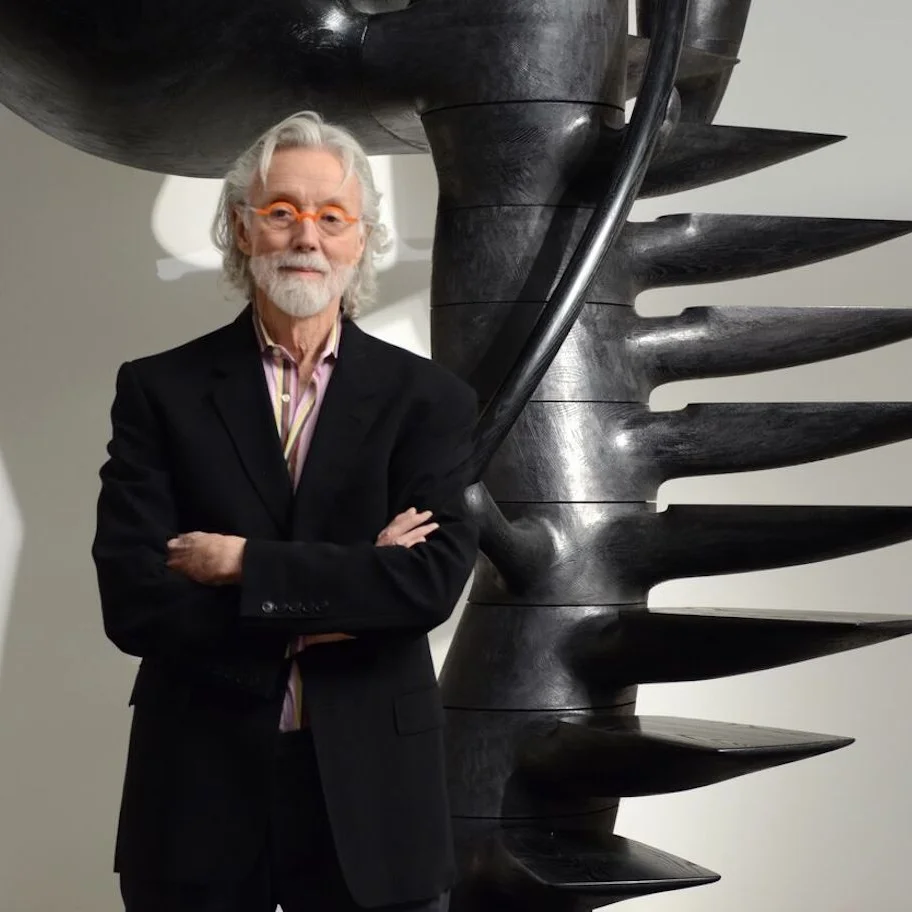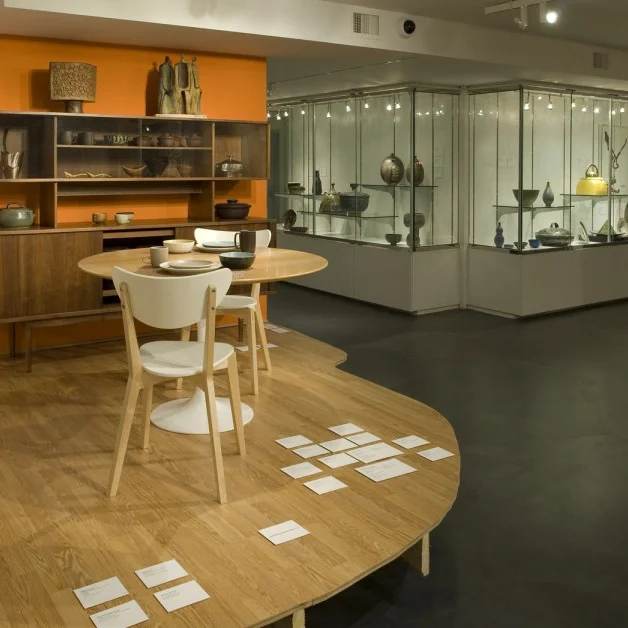Trace the dynamic zigzags, sunbursts, and bullseyes in Liz Collins’s “Zagreb Mountain Scroll” with your eyes, and you can almost hear the exclamations of a sharp impact, cartoon-style: “THWAP!”, “POW!” But this piece isn’t cartoonish or crudely printed, like a vintage comic strip, nor is it precisely painted, like a large-scale Pop Art scene. Look closely, and you’ll see that the surface of each stripe and razor-sharp boundary line is made from a soft, shimmery blend of Jacquard-woven silk and polyester.
Read MoreSilver took a star turn late last year, as Tiffany & Company’s collection “Everyday Objects,” designed by the firm’s chief artistic officer Reed Krakoff, made headlines. Some of them have been choice: the New York Daily Newsoffers commentary on “6 Ridiculous ‘Everyday’ Items from Tiffany & Co.” Fortune notes, with implied humor, that “Tiffany & Co. Is Selling a $1,000 Tin Can.”
Read MoreSince the morning of Sunday, January 21, design Instagram has been awash in images of sinuous objects that defy easy categorization. A silver chair looks as though it could be the tongue of a colossal human figure; a massive white seat resembles nothing so much as a gigantic, gleaming back tooth. Candy-colored neon lamps sit on bases that resemble sturdy elephant’s feet. In some of these images, a slight, silver-haired, bespectacled man looks at the camera, seated on a wild creation with three legs, or at the edge of a sculptural object comprised of curvaceous cones and scoops.
Read MoreThe late, legendary Italian architect and designer Ettore Sottsass has been — to paraphrase Yogi Berra — rediscovered all over again. In recent years, his work has been shared with wide audiences through a series of articles and “explainers,” like this recent short video from Vox, or this 2014 piece about Memphis by Alissa Walker that appeared on Gizmodo. And his profile got a big boost from his prominence in the exhibition Postmodernism: Style and Subversion, 1970—1990 at the Victoria & Albert Museum in 2011.
Read MoreIf the current leader of the free world is, as Fran Lebowitz described him in an interview with Vanity Fair last October, “a poor person’s idea of a rich person,” then the houses Kate Wagner dissects in her blog McMansion Hell are a particular sort of middle-class person’s idea of great estates. There are turrets, balconies, grand foyers, wrought iron that isn’t actually wrought, crystal chandeliers that are probably made of glass, and spiral staircases galore.
Read MoreIt’s not often that a fashion exhibition in New York City presents vintage garments against a backdrop of faux-wood laminate paneling, or accessorizes select pieces with clusters of hanging plants in macramé holders. But Counter-Couture: Handmade Fashion in an American Counterculture, now on view at the Museum of Arts and Design, takes aim at the contested territory that separates DIY practice from luxury craftsmanship. The stretch of time between the late 1960s and early 1970s is a rich moment in which to examine this theme.
Read MoreThe next time you find yourself hate-reading a fawning profile of a photogenic young Brooklyn potter whose hot-pink-rimmed wares are transforming the “stuffy world of ceramics into a cool new craft” (or something to that effect), navigate yourself away from there, and instead visit the website of the Museum of Contemporary Craft (MoCC) in Portland, Oregon. Here you will find a digital record of nimble cultural production that will knock your socks off.
Read MoreVisitors to the official website of the Pussyhat Project are welcomed with an exclamation of color and joy from founders Krista Suh and Jayna Zweiman: “We did it! We created a sea of pink!” And indeed they did. The Women’s March on Washington, D.C., and the 600 allied marches across the United States and the world, drew between 3.3 and 4.6 million protesters, making it one of the largest single-day demonstrations in the nation’s history.
Read MoreReading the post-election commentary from my vintage-furnished stop in the Acela bubble this week, I have felt a kind of nausea and dread that I had not experienced since I nearly lost my stepfather, who worked in the North Tower of the World Trade Center, on September 11, 2001. He survived, but none of us has ever been the same. I knew then that I would devote my life and abilities to the community I love: people who make things, people who enrich others’ lives by teaching and mentoring, people who shine light on injustice through their artwork, who help us find connection with each other.
Read MoreRiotously colorful, densely patterned, and unassailably fabulous, Vlisco fabrics have, for decades, been tailored into shift dresses, power suits, and formal gowns for Central and West Africa’s cosmopolitan elite. Their patterns and palettes evince an instantly recognizable aesthetic. And there are scores of Vlisco imitators: Chinese knockoffs are sold on city streets all over the world. But are any of these fabrics in fact African?
Read MoreOf all the astonishing things Roberto Lugo has done in his career — from creating a DIY potter’s wheel and mixing his own clay from dirt in an urban scrapyard, to creating a new genre of hip-hop-inflected political porcelain — the most radical might be that he is head over heels in love with something rather uncool in the contemporary art world: skill. In his exhibition Defacing Adversity: The Life and Times of Roberto Lugo at Wexler Gallery, Lugo’s creations are bursting with wit and formal mastery, even as they sport the drips and brush marks of graffiti and liberally-applied glaze. The vessels exude a forceful sense of patriotic bling; for his first solo exhibition in his native city, in a gallery within walking distance of Independence Hall, Lugo celebrates the US founding fathers, public intellectuals of color, musicians, poets, and presidential candidates.
Read MoreLeave it to a former professional studio potter to organize a wide-ranging exhibition of postwar ceramics that’s relatively free of hangups about form and function. The Ceramic Presence in Modern Art: Selections from the Linda Leonard Schlenger Collection, currently on view at the Yale University Art Gallery, demonstrates connections of various sorts between works in clay and paintings, drawings, and other forms of sculpture from the period. The exhibition’s core material, and its initial inspiration, is the collection of Linda Leonard Schlenger, one of the world’s foremost collectors of post–World War II American ceramics.
Read MoreWhen the news broke yesterday that Google had a brand new logo — the biggest change to its visual identity since its inception in 1998 — the design twitterverse exploded with commentary about the thickness of the new letterforms and their conspicuous lack of serifs. On Tuesday morning, typographers chimed in with praise and scorn, often about the perception that the rounded characters paired with the company’s signature color-block hues seem too childlike for a technology behemoth.
Read MoreIt’s an illuminating mental exercise to ponder: what if Dr. Albert C. Barnes, the pharmaceutical tycoon and physician who assembled an unmatched collection of Post-Impressionist and early Modern paintings in Philadelphia, was actually an installation artist before his time? This is the central conceit that inspired The Order of Things, now in its final days at the Barnes Foundation. Curated by Drexel University art history professor Martha Lucy, the exhibition comprises three distinct installations by Mark Dion, Judy Pfaff, and Fred Wilson.
Read MoreOne of the greatest pleasures of teaching design history to college students — apart from watching their reactions as I play excerpts from grouchy interviewswith the legendary Braun designer Dieter Rams in class — is time travel. Not the actual temporal kind, but the generational kind, where you realize that you’re the only person in the room who remembers the 1980s, and everyone else in the room is really curious about that.
Read MoreNew Yorkers could be forgiven this month for confusing their museum itineraries with the schedule of a vintage film festival, or an Anna May Wong-inspired Netflix binge. Two exhibitions, China: Through the Looking Glass at the Metropolitan Museum of Art and Matthew Weiner’s Mad Men at the Museum of the Museum of the Moving Image each make manifest (if not exactly “real”) cultural phenomena that are likely to be more familiar to visitors from something they’ve seen on TV or in the movies than from something they’ve encountered in a museum or a gallery.
Read MoreOf his extensive collection of ceramics, Oscar Wilde once remarked: “I find it harder and harder every day to live up to my blue china.” What Wilde felt he was increasingly failing to “live up to” was probably the sort of bourgeois respectability that is often symbolized by a set of good porcelain — something, he was surely aware, to which even a spectacularly talented gay man in Victorian Britain could never hope to aspire. It is a sign that Wilde was onto something that most people only deploy “the good china” a few times a year, on major holidays; the rest of the time, we keep it neatly tucked away so that it won’t get broken.
Read MoreAn elegant black envelope arrived in my mailbox last week. Inside is a square, burgundy-colored folder containing a catalogue of 1950 and ’60s snapshots. On the cover, an off-white, hand-lettered logo reads “Casa Susanna.” The photographs reproduced inside appear at first glance to portray a group of women at leisure: posing in the kitchen, dressed smartly for dinner, sporting fashionable bathing suits, sitting in a field of wildflowers. They are to be sold as a single lot by Wright auction house on October 30.
Read MoreNYC Makers: The MAD Biennial is the closest thing you’ll find to a crowd-sourced exhibition on view in New York right now — perhaps anywhere. Conceived during his first weeks on the job last fall by the Museum of Arts and Design’s (MAD) new director, Glenn Adamson, the show was organized at lightning speed, by museum standards: eight months. A brain trust of 300 leaders from New York’s cultural community nominated a pool of artists, designers, and fabricators of various sorts, which was then winnowed to about 100 participants by a jury that included Adamson, the exhibition’s curator, Jake Yuzna, and MAD Chief Curator Lowery Stokes Sims.
Read MoreThere are two public works on view in the Northeast right now by the Berlin-based artist Katharina Grosse. One, in Philadelphia, zips past as you ride a moving train; the other, in Brooklyn, inspires you to stand still and look closely. Both works introduce unexpected bursts of saturated color into ordinary, even dreary urban settings.
Read More



















